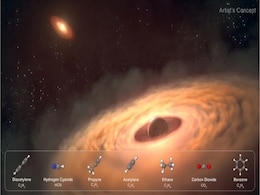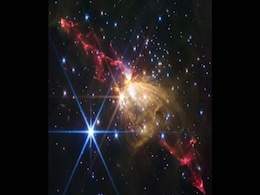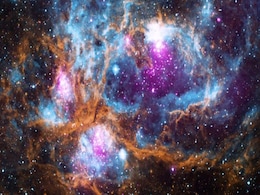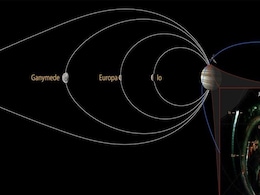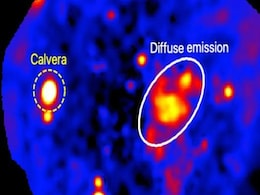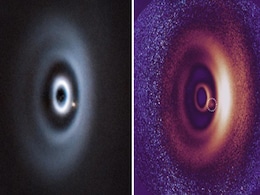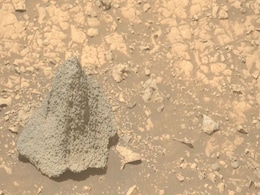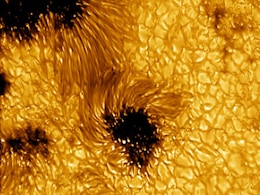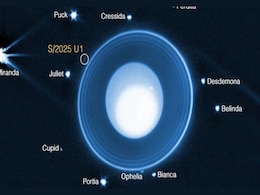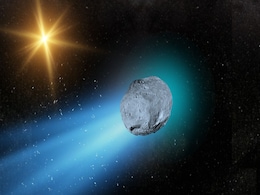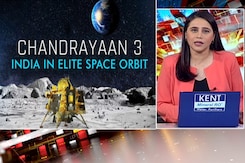Space Discoveries
- All
- News
- Videos
-

James Webb Offers First Glimpse Into How Moons Are Built Around Distant Planets
- Wednesday October 1, 2025
- Written by Gadgets 360 Staff
The James Webb Space Telescope has detected carbon-bearing molecules in a moon-forming disk surrounding CT Cha b, a massive planet-like object orbiting a young star 625 light-years away. The discovery marks the first measurement of its kind and offers clues to how moons like those around Jupiter and Saturn might have formed.
-
 www.gadgets360.com
www.gadgets360.com
-

Moon Is Rusting: Scientists Stunned By Hematite Discovery On Lunar Surface
- Wednesday September 24, 2025
- Science | Edited by Srishti Singh Sisodia
Understanding of rusting could impact future lunar missions, resource utilisation and equipment design.
-
 www.ndtv.com
www.ndtv.com
-

James Webb Space Telescope Spots Rare Protostar Blasting Twin Jets Across Milky Way
- Friday September 12, 2025
- Written by Gadgets 360 Staff
NASA’s James Webb Space Telescope has captured a rare protostar about ten times the Sun’s mass blasting twin jets nearly eight light-years long. The beams carve through the glowing Sharpless 2-284 nebula, offering astronomers a vivid glimpse into how massive stars form and shape their galactic environment.
-
 www.gadgets360.com
www.gadgets360.com
-

NASA’s Perseverance Rover Finds Potential Signs of Life in Mars Rock Sample
- Thursday September 11, 2025
- Written by Gadgets 360 Staff
NASA’s Perseverance rover has uncovered iron-rich minerals in Jezero Crater rocks that on Earth often link to microbial activity. The discovery suggests Mars’ lake basin may have been more hospitable than thought. Still, scientists caution that only Earth-based analysis can confirm whether these are true biosignatures.
-
 www.gadgets360.com
www.gadgets360.com
-

Universe’s First Stars May Have Been Smaller Than Astronomers Once Believed
- Tuesday September 9, 2025
- Written by Gadgets 360 Staff
Astronomers once thought the universe’s first stars were only massive giants. New simulations and lab experiments reveal turbulence and early chemistry allowed smaller, Sun-like stars to form too. This discovery reshapes our view of cosmic dawn, showing the first stellar generation was more diverse than previously believed.
-
 www.gadgets360.com
www.gadgets360.com
-

James Webb Spots Bizarre Planet-Forming Disk Full of Carbon Dioxide
- Friday September 5, 2025
- Written by Gadgets 360 Staff
The James Webb Space Telescope has spotted a bizarre planet-forming disk dominated by carbon dioxide where water is almost absent. This rare finding, in star system XUE 10 within NGC 6357, challenges current models of planetary formation and may reshape our understanding of habitable worlds.
-
 www.gadgets360.com
www.gadgets360.com
-

NASA’s Juno Spacecraft Detects Callisto’s Aurora, Completing Jupiter’s Galilean Moons Set
- Wednesday September 3, 2025
- Written by Gadgets 360 Staff
NASA’s Juno spacecraft has captured Callisto’s elusive auroral footprint, completing the “family portrait” of Jupiter’s Galilean moons. Each moon carves its own aurora into the gas giant’s poles, revealing how they interact with Jupiter’s powerful magnetosphere. Callisto’s faint arc appeared during a 2019 flyby, finally confirming i...
-
 www.gadgets360.com
www.gadgets360.com
-

Astronomers Discover Calvera, a Runaway Pulsar Racing Above the Milky Way
- Wednesday September 3, 2025
- Written by Gadgets 360 Staff
Astronomers have discovered Calvera, a pulsar speeding 6,500 light-years above the Milky Way’s disk. Formed from a supernova in a nearly empty region, Calvera challenges long-held ideas of star birth and death. Its discovery reveals that extreme stellar events can occur even in the galaxy’s sparse outer halo.
-
 www.gadgets360.com
www.gadgets360.com
-

James Webb Space Telescope Spots Planet-Building Dust in the Butterfly Nebula
- Friday August 29, 2025
- Written by Gadgets 360 Staff
The James Webb Space Telescope has unveiled stunning new details of the Butterfly Nebula, a planetary nebula 3,400 light-years away. Using its infrared vision, Webb detected crystalline silicates, large dust grains, and carbon-rich PAH molecules within the nebula’s dusty torus. These discoveries reveal how dying stars recycle minerals and organic...
-
 www.gadgets360.com
www.gadgets360.com
-

A Planet Is Being Born: Astronomers Capture Rare Cosmic Snapshot
- Saturday August 30, 2025
- Written by Gadgets 360 Staff
Astronomers have captured a groundbreaking sight: WISPIT 2b, a baby gas giant planet forming within a dusty, multi-ring protoplanetary disk around a young Sun-like star 430 light-years away. Infrared images from the Very Large Telescope show the planet carving a dark path in the rings as it feeds on gas and dust. This rare discovery provides the fi...
-
 www.gadgets360.com
www.gadgets360.com
-

NASA’s Perseverance Rover Spots Helmet-Like Rock on Mars, Sparks Geology Debate
- Saturday August 30, 2025
- Written by Gadgets 360 Staff
NASA’s Perseverance rover has photographed a helmet-shaped rock on Mars. Nicknamed “Horneflya,” the unusual spherule-covered formation intrigues scientists exploring how water, volcanic activity, or chemical processes shaped the Martian surface. Captured by Mastcam-Z, the discovery adds to Perseverance’s catalogue of strange formations and ...
-
 www.gadgets360.com
www.gadgets360.com
-

Astronomers Capture Sharpest-Ever Solar Flare Images with NSF’s DKIST Telescope
- Wednesday August 27, 2025
- Written by Gadgets 360 Staff
Astronomers have achieved a major breakthrough by capturing the sharpest images of a solar flare ever recorded, using the National Science Foundation’s Daniel K. Inouye Solar Telescope (DKIST). Observed at the hydrogen-alpha wavelength during the decay of an X1.3-class solar flare, the images unveiled hundreds of ultra-fine coronal loops averagin...
-
 www.gadgets360.com
www.gadgets360.com
-

Astronomers Detect RBFLOAT, Brightest Fast Radio Burst Ever Observed
- Monday August 25, 2025
- Written by Gadgets 360 Staff
An international team of astronomers has detected RBFLOAT, the brightest fast radio burst (FRB) ever recorded, just 130 million light-years away in Ursa Major. Detected by CHIME in March 2025, the powerful radio flash was traced to galaxy NGC-4141. Follow-up imaging with the James Webb Space Telescope revealed a faint stellar source near the burst,...
-
 www.gadgets360.com
www.gadgets360.com
-

James Webb Telescope Discovers Tiny New Moon Orbiting Uranus
- Saturday August 23, 2025
- Written by Gadgets 360 Staff
A team from the Southwest Research Institute has discovered a tiny new moon orbiting Uranus using NASA’s James Webb Space Telescope. The moon, called S/2025 U1, is just 6 miles (10 kilometers) wide, too small for Voyager 2 to detect during its 1986 flyby. This discovery brings Uranus’s total known moons to 29, with S/2025 U1 orbiting 35,000 mil...
-
 www.gadgets360.com
www.gadgets360.com
-

Devil Comet’s Water Matches Earth, Strengthening Theory of Cosmic Origins
- Saturday August 23, 2025
- Written by Gadgets 360 Staff
Astronomers discovered that the water in Comet 12P/Pons-Brooks, known as the “Devil Comet,” is nearly identical to Earth’s. Using ALMA and IRTF data, they mapped cometary water for the first time. The findings bolster the theory that comets delivered water to Earth, enabling life’s emergence.
-
 www.gadgets360.com
www.gadgets360.com
-

James Webb Offers First Glimpse Into How Moons Are Built Around Distant Planets
- Wednesday October 1, 2025
- Written by Gadgets 360 Staff
The James Webb Space Telescope has detected carbon-bearing molecules in a moon-forming disk surrounding CT Cha b, a massive planet-like object orbiting a young star 625 light-years away. The discovery marks the first measurement of its kind and offers clues to how moons like those around Jupiter and Saturn might have formed.
-
 www.gadgets360.com
www.gadgets360.com
-

Moon Is Rusting: Scientists Stunned By Hematite Discovery On Lunar Surface
- Wednesday September 24, 2025
- Science | Edited by Srishti Singh Sisodia
Understanding of rusting could impact future lunar missions, resource utilisation and equipment design.
-
 www.ndtv.com
www.ndtv.com
-

James Webb Space Telescope Spots Rare Protostar Blasting Twin Jets Across Milky Way
- Friday September 12, 2025
- Written by Gadgets 360 Staff
NASA’s James Webb Space Telescope has captured a rare protostar about ten times the Sun’s mass blasting twin jets nearly eight light-years long. The beams carve through the glowing Sharpless 2-284 nebula, offering astronomers a vivid glimpse into how massive stars form and shape their galactic environment.
-
 www.gadgets360.com
www.gadgets360.com
-

NASA’s Perseverance Rover Finds Potential Signs of Life in Mars Rock Sample
- Thursday September 11, 2025
- Written by Gadgets 360 Staff
NASA’s Perseverance rover has uncovered iron-rich minerals in Jezero Crater rocks that on Earth often link to microbial activity. The discovery suggests Mars’ lake basin may have been more hospitable than thought. Still, scientists caution that only Earth-based analysis can confirm whether these are true biosignatures.
-
 www.gadgets360.com
www.gadgets360.com
-

Universe’s First Stars May Have Been Smaller Than Astronomers Once Believed
- Tuesday September 9, 2025
- Written by Gadgets 360 Staff
Astronomers once thought the universe’s first stars were only massive giants. New simulations and lab experiments reveal turbulence and early chemistry allowed smaller, Sun-like stars to form too. This discovery reshapes our view of cosmic dawn, showing the first stellar generation was more diverse than previously believed.
-
 www.gadgets360.com
www.gadgets360.com
-

James Webb Spots Bizarre Planet-Forming Disk Full of Carbon Dioxide
- Friday September 5, 2025
- Written by Gadgets 360 Staff
The James Webb Space Telescope has spotted a bizarre planet-forming disk dominated by carbon dioxide where water is almost absent. This rare finding, in star system XUE 10 within NGC 6357, challenges current models of planetary formation and may reshape our understanding of habitable worlds.
-
 www.gadgets360.com
www.gadgets360.com
-

NASA’s Juno Spacecraft Detects Callisto’s Aurora, Completing Jupiter’s Galilean Moons Set
- Wednesday September 3, 2025
- Written by Gadgets 360 Staff
NASA’s Juno spacecraft has captured Callisto’s elusive auroral footprint, completing the “family portrait” of Jupiter’s Galilean moons. Each moon carves its own aurora into the gas giant’s poles, revealing how they interact with Jupiter’s powerful magnetosphere. Callisto’s faint arc appeared during a 2019 flyby, finally confirming i...
-
 www.gadgets360.com
www.gadgets360.com
-

Astronomers Discover Calvera, a Runaway Pulsar Racing Above the Milky Way
- Wednesday September 3, 2025
- Written by Gadgets 360 Staff
Astronomers have discovered Calvera, a pulsar speeding 6,500 light-years above the Milky Way’s disk. Formed from a supernova in a nearly empty region, Calvera challenges long-held ideas of star birth and death. Its discovery reveals that extreme stellar events can occur even in the galaxy’s sparse outer halo.
-
 www.gadgets360.com
www.gadgets360.com
-

James Webb Space Telescope Spots Planet-Building Dust in the Butterfly Nebula
- Friday August 29, 2025
- Written by Gadgets 360 Staff
The James Webb Space Telescope has unveiled stunning new details of the Butterfly Nebula, a planetary nebula 3,400 light-years away. Using its infrared vision, Webb detected crystalline silicates, large dust grains, and carbon-rich PAH molecules within the nebula’s dusty torus. These discoveries reveal how dying stars recycle minerals and organic...
-
 www.gadgets360.com
www.gadgets360.com
-

A Planet Is Being Born: Astronomers Capture Rare Cosmic Snapshot
- Saturday August 30, 2025
- Written by Gadgets 360 Staff
Astronomers have captured a groundbreaking sight: WISPIT 2b, a baby gas giant planet forming within a dusty, multi-ring protoplanetary disk around a young Sun-like star 430 light-years away. Infrared images from the Very Large Telescope show the planet carving a dark path in the rings as it feeds on gas and dust. This rare discovery provides the fi...
-
 www.gadgets360.com
www.gadgets360.com
-

NASA’s Perseverance Rover Spots Helmet-Like Rock on Mars, Sparks Geology Debate
- Saturday August 30, 2025
- Written by Gadgets 360 Staff
NASA’s Perseverance rover has photographed a helmet-shaped rock on Mars. Nicknamed “Horneflya,” the unusual spherule-covered formation intrigues scientists exploring how water, volcanic activity, or chemical processes shaped the Martian surface. Captured by Mastcam-Z, the discovery adds to Perseverance’s catalogue of strange formations and ...
-
 www.gadgets360.com
www.gadgets360.com
-

Astronomers Capture Sharpest-Ever Solar Flare Images with NSF’s DKIST Telescope
- Wednesday August 27, 2025
- Written by Gadgets 360 Staff
Astronomers have achieved a major breakthrough by capturing the sharpest images of a solar flare ever recorded, using the National Science Foundation’s Daniel K. Inouye Solar Telescope (DKIST). Observed at the hydrogen-alpha wavelength during the decay of an X1.3-class solar flare, the images unveiled hundreds of ultra-fine coronal loops averagin...
-
 www.gadgets360.com
www.gadgets360.com
-

Astronomers Detect RBFLOAT, Brightest Fast Radio Burst Ever Observed
- Monday August 25, 2025
- Written by Gadgets 360 Staff
An international team of astronomers has detected RBFLOAT, the brightest fast radio burst (FRB) ever recorded, just 130 million light-years away in Ursa Major. Detected by CHIME in March 2025, the powerful radio flash was traced to galaxy NGC-4141. Follow-up imaging with the James Webb Space Telescope revealed a faint stellar source near the burst,...
-
 www.gadgets360.com
www.gadgets360.com
-

James Webb Telescope Discovers Tiny New Moon Orbiting Uranus
- Saturday August 23, 2025
- Written by Gadgets 360 Staff
A team from the Southwest Research Institute has discovered a tiny new moon orbiting Uranus using NASA’s James Webb Space Telescope. The moon, called S/2025 U1, is just 6 miles (10 kilometers) wide, too small for Voyager 2 to detect during its 1986 flyby. This discovery brings Uranus’s total known moons to 29, with S/2025 U1 orbiting 35,000 mil...
-
 www.gadgets360.com
www.gadgets360.com
-

Devil Comet’s Water Matches Earth, Strengthening Theory of Cosmic Origins
- Saturday August 23, 2025
- Written by Gadgets 360 Staff
Astronomers discovered that the water in Comet 12P/Pons-Brooks, known as the “Devil Comet,” is nearly identical to Earth’s. Using ALMA and IRTF data, they mapped cometary water for the first time. The findings bolster the theory that comets delivered water to Earth, enabling life’s emergence.
-
 www.gadgets360.com
www.gadgets360.com

